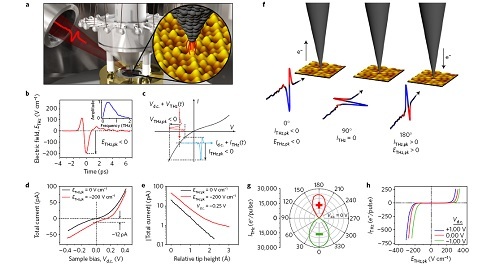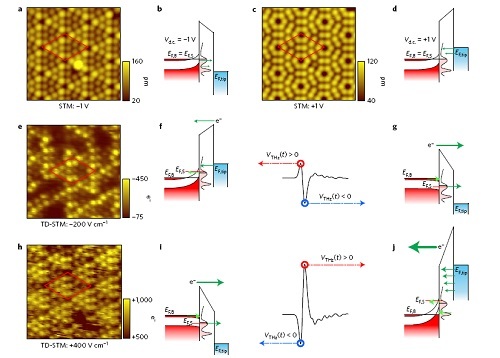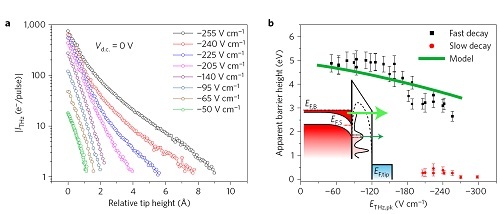Guide
The ultra-fast control of the current at the atomic level is critical to the future innovation of nanoelectronics. Previous studies have shown that coupling picosecond-scale terahertz pulses to metal nanostructures can achieve extremely local transient electric fields on the nanometer scale.
text
Recently, the research group of Professor Frank A. Hegmann of the University of Alberta in Canada has independently developed a terahertz-scan on the commercial ultra-high vacuum scanning tunneling microscope (RHK-UHV-SPM 3000) system produced by RHK Technology in the United States. Tunneling microscope (THz-STM), the first time to perform atomic resolution THz-STM measurement on the surface of Si (111)-(7 × 7) samples in ultra-high vacuum, showing the exploration of atomic precision in THz-STM in ultra-high vacuum Super ability of ultra-fast non-equilibrium tunnel dynamics.

Figure 1: Using THz-STM to control extreme tunnel current in ultra-high vacuum
As you can see in Figure 1 (a), ultra-fast terahertz (THz) pulses are focused on the ultra-high vacuum (middle) STM probe through the lens (left side) on the reverse window, at the tunnel junction (inset) Tunnel current is generated. Figure 1 (c) shows that the terahertz pulse coupled to the STM tip induces a time-dependent bias (VTHz (t), solid red line), driving an ultrafast terahertz induced current (ITHz (t), solid blue Line), resulting in a rectified average tunnel current. Terahertz pulse polarity (0 °, 90 °, 180 °) can be used to control the rectified tunneling current caused by terahertz pulses, as shown in Figure 1 (e). Electrons flow from the sample to the tip, producing negative terahertz polarity, and from the tip to the sample have positive terahertz polarity.

Figure 2: Ultrafast control of single atom non-equilibrium tunneling on Si (111)-(7 × 7)
The tunneling current driven by the extreme terahertz pulse is as high as 107 times the steady-state current in the conventional STM, which realizes the imaging of a single atom on the silicon surface with a spatial resolution of 0.3nm, thereby determining the ultrafast terahertz at high current levels Pulse-driven tunnels can indeed be localized into a single atom. In addition, the test results indicate that to explain the atomic ripple of the terahertz-driven STM (TD-STM) image on Si (111)-(7 × 7) (in which hundreds of electrons tunnel within the sub-picosecond time scale), it requires Understand that non-equilibrium charging dynamics are caused by terahertz pulses on the silicon surface. At the same time, the direction of the terahertz driving tunnel current of a single atom can be controlled by the polarity of the terahertz pulse electric field. At terahertz frequencies, the metal-like Si (111)-(7 × 7) surface cannot shield the electric field from bulk electrons, resulting in a difference in the basic mechanism of the conductance between the terahertz tunnel and the steady-state tunnel. Obviously, such an extreme transient current density will not affect the single-atom STM tip or the sample surface atoms under study, just like Si (111)-(7 × 7) with such a large tunnel current in traditional STM testing. .

Figure 3: Hot electrons in terahertz induced current
An additional contribution from the tunneling current of hot electrons was observed in the high terahertz field. Ultra-fast terahertz-induced band bending and non-equilibrium charging of the surface state open up new conduction paths, allowing extremely transient tunneling current to flow between the tip and the sample. The THz-STM on the semiconductor surface provides new insights into the ultra-fast tunneling dynamics at the atomic scale, which is critical for the development of new silicon nanoelectronics and atomic-scale devices that operate at terahertz frequencies.
RHK-UHV-SPM 3000, a commercial ultra-high vacuum scanning tunneling microscope from the US, provides a stable and reliable foundation for the research and development of THz-STM At the same time, I hope more scientific researchers can carry out fruitful academic research on the THz-STM experimental platform. ?
references:
1. Tyler L. Cocker, Frank A. Hegmann et al. An ultrafast terahertz scanning tunneling microscope. Nature Photonics, 151 (2013).
2. Vedran Jelic, Frank A. Hegmann et al. Ultrafast terahertz control of extreme tunnel currents through single atoms on a silicon surface. Nature Physics, 4047 (2017).
Glow In The Dark Puzzle,Puzzle Animals,Glitter Puzzles Kids,Glitter Jigsaw Puzzles
Hangzhou Wonderlandtoys Co., Ltd , https://www.wonderlandtoyscn.com